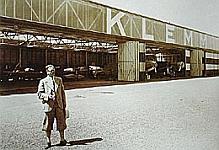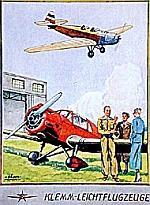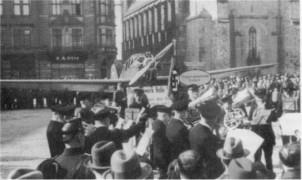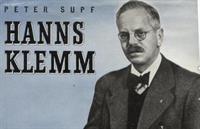Daimler Motoren Gesellschaft
Leichtflugzeugbau Klemm GmbH
The company was founded in Böblingen in 1926 by Dr. Hanns Klemm, who had previously worked for both Zeppelin and the Daimler Aircraft Company.
While working at Daimler Klemm had developed his ideas for a light aircraft, to be made of wood for strength and lightness. It should be easy to manufacture, aerodynamically efficient with low mass and wing loading, for which a low-powered engine would be sufficient. Klemm's first design, the Daimler L.15, was a light aircraft with a single 7.5 hp Indian motorcycle engine. This aircraft flew in early 1919, although a 12 hp Harley-Davidson engine was used instead of the originally-envisioned engine.
Klemm then designed a squared-off version of the cylindrical fuselage of the L.15, which could be more easily built, which he designated the L.20, and he founded his own company to produce it. This aircraft, of which more than 100 were built, was powered by a 20 hp Daimler engine designed by Ferdinand Porsche.
In 1928 Friedrich Karl von Koenig-Warthausen made a solo flight to Moscow in a Klemm L.20, then decided to keep on going, circumnavigating the world and earning himself the Hindenburg Cup, the highest German honour for aeronautical achievement.
From the L.20 was developed the Klemm L.25, later redesignated the Kl 25. Capable of being fitted with fourteen different engine types, over 600 were sold, and licenses to manufacture them were issued in Great Britain and the USA. Klemm was an important employer in Böblingen. The number of employees grew from 50 in 1928 to 250 in 1933 and to about 900 employees in 1941. The apprenticeship program at Klemm was considered exemplary.
In January 1930 Mohamed Sidki flew from Berlin to Cairo, Egypt in a Klemm L25a. He landed in Cairo on 26 January, becoming a political hero by defying the British authorities who had denied him permission to land (he became known as The First Egyptian Eagle). Sidki wrote a letter to Klemm, who had helped outfit the plane for the long journey, stating "your beautiful little machine, the L25a has carried me through wind, snow and torrential rain without any damage to myself, the plane and the engine."
In 1931 Elly Beinhorn became the second woman to fly from Europe to Australia flying a Klemm Kl 26 equipped with an Argus engine, and winning the Hindenburg Cup.The Klemm company earned the reputation of being very innovative and commercially very successful. Hanns Klemm's vision was to build aeroplanes which, like cars, would allow a much wider circle of people to buy and run a plane. That meant a plane which was easy to manufacture and cheap to maintain, and ideally also fit in a garage. All development had to be subordinated to this primary goal.
For this reason Klemm aircraft were not spectacular as far as horsepower and speed are concerned, but they were spectacularly economical and practical. Almost every flyer in Germany in the 20's and 30's learned to fly in a Klemm. In 1932, production reached 25 planes per month
Klemm suffered a setback in 1935 when the prototype Kl 35 crashed during testing at Rechlin. This was explained as a material defect, but was more likely due to overstressing of the wings. Klemm revised and brought the Kl 35 up to the required specifications and manufacturing began. Around 2,000 of the aircraft were built, both at Klemm's plant, and by Fieseler, and later by the Czech company Moravan Otrokovice, for the Luftwaffe as a trainer. During World War II Klemm produced and designed a range of aircraft, such as the Klemm Kl 105, Kl 106 and Kl 107, as well as the Klemm Kl 151 and Kl 152.
In 1933 the National Socialists came to power in Germany and Hanns Klemm too, swept up by the spirit of national resurgence, joined the Nazi party in 1933. He soon became overwhelmed with the demands of the party, which took away control of his company. He quit the party and was severely persecuted by the Gestapo into the 1940s.








